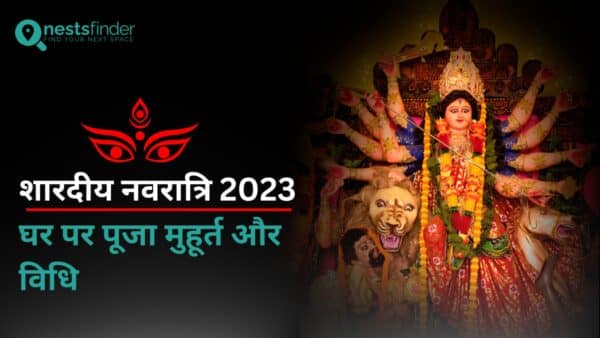Shardiya Navratri 2023: Pooja muhurat and vidhi at home
The Shardiya Navratri 2023 Date is the nine-day Hindu event starting from October 15 to October 23, 2023. People are currently looking for the whole Shardiya Navratri 2023 , which has been made public in accordance with the Panchang. The Navratri Muhurat Timing is frequently used by devotees in their prayers. The information about the Navratri 2023 celebrations , the Shardiya Navratri 2023, and other information is now available to you in this post.
Shardiya Navratri 2023 Date
The Hindu festival which is observed in the honour of Goddess Durga is known as Navratri One of nine Goddesses is worshipped each day during the most well-known celebration, which lasts nine days. The festival of Navratri occurs twice a year, once in the months of Chaitra and Ashvin (March and April and September and October, respectively) and once in the months of Chaitra and Ashvin (September and October). Different regions of the country observe Navratri for different reasons. Nav, which means “nine,” and Ratri, which means “night,” are the roots of the word Navratri.
The devotees have already begun the celebrations, and the pandals for the Durga Pooja Celebrations have already been set up because Shardiya Navratri 2023 is right around the corner . Every day of Navratri is significant and honours a different goddess. The Durga Maa Aarti and Garba are used to celebrate the occasion in Gujarat. On each of the nine days of Navratri, Garba nights are common in many states. People have been looking at the Navratri schedule, dates, and times for 2023, and they know that the first day will start on October 15, 2023. On October 23, 2023, the nine days will come to a close, and Vijaya Dashami, or Dussehra, will take place the next day.
Navratri 2023 Puja Vidhi At Home
A nine-day Hindu festival called Navratri is held in honour of the goddess Durga. Depending on the location, the festival is held either in the spring or the autumn.
Day 1: Kalash Sthapana
The First day of Navratri, is so named. A Kalash is set up in the puja room on this day. The goddess Durga’s symbol, the Kalash, is a vessel that holds rice, water, and other auspicious items. The first day of Navratri is dedicated to the goddess Shailputri, and it is believed to wear orange on this day. One of the nine Devis, Shailputri is the daughter of Hamavat. She represents the Trimurti, which is made up of Brahma, Vishnu, and Mahesh.
Procedure
Cleaning and decorating the puja space.
Place the Kalash at the pooja room’s east corner.
Fill the Kalash with water up to the neck.
Put a few grains of rice in the Kalash.
Place a coconut on top of the rice.
Tie a red thread around the coconut
Fill the Kalash with a few coins, betel leaves, and durva grass.
Offer the goddess Durga your prayers.
Day 2 : Goddess Brahmacharini
The second day of Navratri is dedicated to the goddess Brahmacharini, and it is suggested to wear white on this day. She is the Goddess of Penance and wears a white sari. She has a kamandal in the other hand and a rosary in the other. According to popular belief, those who offer prayers are blessed with insight and knowledge.
Day 3: Goddess Chandraghanta
The third day of Navratri is dedicated to the goddess Chandraghanta, and it is believed to wear red on this day. Goddess Chandraghanta, who rules over the planet Shukra, is honoured on this day with yellow flowers. She has a semi-circular moon on her forehead.
Day 4 : Goddess Kushmanda
The fourth day of Navratri is dedicated to Goddess Kushmanda, who is said to wear red, her favourite colour. Due to its red colour, it is thought to drink beetroot or carrot juice on this day. The passion and might are reflected in the Goddess Kushmanda.
Day 5: Goddess Skand Mata
The fifth day of Navratri is dedicated to Goddess Skand Mata, who is also referred to as one of Goddess Durga’s five avatars. She is the mother of Lord Karthikeya, who served as the principal commander in the battle against evil. Dried blueberries and prunes are available to devotees on this day, which also has a blue sky.
Day 6: Goddess Katyayani
The sixth day of Navratri is dedicated to Goddess Katyayani, the sixth form of Maa Durga. On this day, followers are encouraged to wear pink since they think she is the remover of bad spirits. This day represents fresh beginnings and new hope. A rose petal kulfi is seen to be the highlight of the day.
Day 7 : Maa Kaalratri
The seventh day of Navratri is dedicated to Maa Kaalratri, the deadliest manifestation of Goddess Durga who is famed for giving her followers strength and serenity. The most significant colour on this day is thought to be royal blue. The most auspicious dessert, nariyal ki barfi, is permissible on this day.
Day 8: Maa Mahagauri
The eighth day of Navratri, is dedicated to Maa Mahagauri. Yellow is the most prominent colour on this day, which is observed as Ashtami, stands for joy and optimism in life. The best aspect of this day’s celebration is regarded as the offering of kesar kheer.
Day 9 : Maa Siddhidatri
The ninth and last day of Navratri, known as Navmi, is when Maa Siddhidatri is worshipped. Green, which represents prosperity, can be used to commemorate this day. You can celebrate this day by preparing a delicious meal with a green hue. Offering chane, halwa, and poori to young girls helps celebrate this day.
Conclusion
Shardiya Navratri 2023 is a festival of great devotion and spiritual significance. You welcome the heavenly benefits into your home by keeping the puja muhurat and adhering to the vidhi with sincerity and faith. Keep in mind that the true meaning of every event lies not only in the rituals but also in the sincerity and purity of the devotion. May you and your family experience great joy, wealth, and spiritual enlightenment during Navratri. Jai Mata Di!




